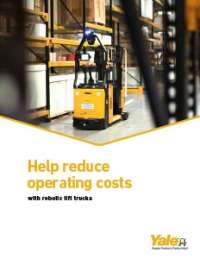Justifying the Next-Gen Investment
Early materials handling AGVs relied on ground wires, tape, magnets, and reflectors, but today’s robotic lift trucks operate without any added infrastructure and are unrestricted by fixed routes.
This offers great strides forward in terms of flexibility, ease of use and productivity.
For example, Yale® robotic lift trucks equipped with Driven by Balyo technology build a map of the facility and self-locate in real time, navigating infrastructure free and easily responding to unexpected obstructions.
As the competitive landscape continues to intensify, materials handling operations cannot afford an investment that does not pay off, so translating these benefits from theoretical to tangible reality is key.
The business climate also requires a reasonably fast return on investment (ROI). The more shifts an operation runs, the sooner they can reap a full return on their robotic lift truck investment – oftentimes less than two years for two- or three-shift operations.
Reduced Turnover and Training Time
According to the Bureau of Labor Statistics, the turnover rate for warehouse workers is 36 percent. Moreover, filling newly vacant positions can cost anywhere from 25 to 150 percent of the employee’s salary.
Though training periods can vary based on the nature of the job, one thing remains constant - training inexperienced or unskilled employees is costly. Companies like Amazon have used automated systems to reduce the time it takes to train employees, bringing new hires up to speed in as little as two days using technology like touch screens and robots.
Adopting automated transportation solutions like robotic lift trucks can help simplify tasks reserved for employees. For example, in goods-to-operator fulfillment workflows, employees do not need to know the storage location for inventory required for each order; rather, they can focus on picking and packing orders as quickly as possible from the inventory brought to them by a robotic solution.
Implementing robotic lift trucks does not take away high-value-added jobs from human workers. In fact, U.S. warehouses had 600,000 unfilled jobs as of May 2017. Using automated solutions like robotic lift trucks can help managers address the labor shortage and free employees to advance to more engaging, meaningful positions – helping curb turnover.
Lower Long-term Costs and Investment
When automating processes and calculating the associated payback, direct labor savings are obvious wins, with expenses like hourly wages, overtime and holiday pay rising to the top.
But automation drives savings in other indirect ways by drastically reducing costs associated with:
- Retraining and re-education
- Insurance
- Workers’ compensation
- Lost time due to illness or injury
- Long-term wage increases
Robotics can also bring out the best in employees. Fostering “cobotics,” with humans working alongside robots, leverages the strengths of both to make repetitive tasks and more complex, value-added functions more efficient.
This can provide new opportunities for people with physical limitations, like limited mobility, to serve as integral parts of certain processes, such as using automated systems to move inventory to pickers, helping keep throughput flowing.
To read the full paper download The ROI of Robotics: Financial and Operational Sense
Download The ROI of Robotics: Financial and Operational Sense
Article topics
Email Sign Up






















